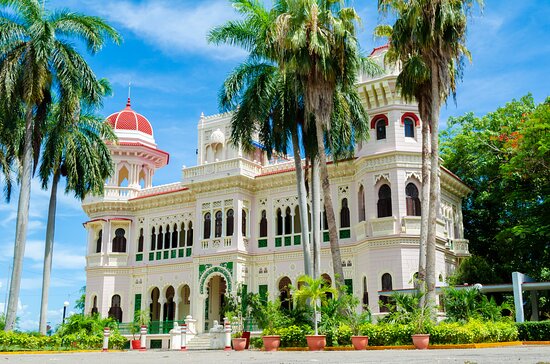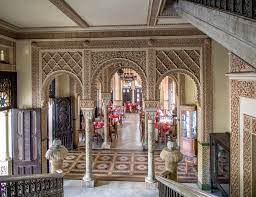LA CIUDAD DE CIENFUEGOS. CUBA Y SU IMPRESIONANTE PALACIO DEL VALLE, PATRIMONIO CULTURAL. FOTOS
La ciudad de Cienfuegos, capital de la provincia de Cienfuegos, es una ciudad en la costa sur de Cuba. Se encuentra a unos 250 km (160 millas) de La Habana y tiene una población de 164.924. Desde finales de la década de 1960, Cienfuegos se ha convertido en uno de los principales centros industriales de Cuba, especialmente en los sectores energético y azucarero.
La ciudad recibe el nombre de La Perla del Sur (Perla del Sur). A pesar de ser conocida como una ciudad industrial de fábricas y varias plantas nucleares/eléctricas, y el nombre Cienfuegos se traduce literalmente como “cien fuegos” (cien, “cien”; fuegos, “fuegos”).
En realidad, la ciudad toma su nombre del apellido del asturiano José Cienfuegos Jovellanos, Capitán General de Cuba (1816-19).
EL PALACIO DEL VALLE
Cuando Acisclo Valle comenzó a construir su mansión en 1913, difícilmente podía imaginar que la instalación eventualmente se convertiría en un símbolo de la Perla del Sur. El palacio está ubicado en la zona de La Punta, Monumento Nacional Patrimonio Cultural.
El Palacio del Valle, es una villa histórica en Cienfuegos, Cuba, construida por el arquitecto italiano Alfredo Colli, de 1913 a 1917 y que recuerda a la arquitectura árabe.
El cliente original de la villa fue el comerciante cubano Celestino Caces, quien luego la vendió al asturiano Acisclo del Valle Blanco, quien hizo finalizar su construcción. Hoy en día, la villa está ocupada por un hotel y restaurante de lujo.
El terreno está ubicado en el barrio Punta Gorda y fue un regalo de bodas del padre de Amparo Suero, cuando ella se casó con Acisclo, un rico empresario. Se rumorea que la pareja estaba de viaje por España cuando decidieron construir un chalet singular.
Fijaron allí su residencia y las obras finalizaron en 1917, cuando se ampliaron la existente “Quinta Morisca”. Los diseños fueron realizados por un arquitecto cienfueguero y ejecutados bajo la supervisión del ingeniero civil italiano Alfredo Colli Fanconetti.
¿Curiosidad? Levantaron el ecléctico edificio a un costo de millón y medio de pesos. Artesanos franceses, árabes, italianos y cubanos trabajaron con mármol, alabastro, latón, vidrio y cerámica importados de España, Italia y Estados Unidos. Acisclo sólo disfrutó del Palacio durante 3 años. Murió en 1920 y legó el estado a su esposa y sus siete hijos.
Un vistazo a la planta central es bastante sorprendente. Está flanqueada por 2 esfinges de animales de cuentos egipcios, con cabeza y pecho de mujer y cuerpo y patas de león que personifican el sol. Sin embargo, algunas personas aseguran que esta no debía ser la entrada principal. Sin embargo, su proximidad a la escalera de mármol que conduce al segundo piso lo hizo así.
La entrada es de estilo gótico primitivo y da paso a un comedor de influencia mudéjar, que imita el famoso Patio de los Leones, de la Alhambra de Granada. Luego viene el salón de música y juegos, de estilo Luis XV, y el foyer de estilo Imperial, con frisos dorados, zócalos de mármol rosado, aplicaciones de latón y piso de mármol blanco. El segundo piso tiene 8 dormitorios, además de salas de estar y estudio.
Las iniciales del propietario están entrecruzadas formando un artístico monograma en el suelo de cerámica. Algunas columnas interiores y exteriores recuerdan a la Mezquita de Córdoba, en España
El edificio remata en 3 torres: gótica romana, indiana y una mignonette de estilo árabe, además de una glorieta en la cubierta.
Jarrones de porcelana italiana y china se encuentran esparcidos por todo el palacio. Evidencian la opulencia de la época burguesa en Cuba y un tipo de construcción que imita estilos extranjeros. Nos muestran cómo Acisclo del Valle dejó volar su dinero y su imaginación.
Fue abandonado en 1922, cuando la propietaria y sus hijos viajaron a España. Luego, durante algún tiempo se convirtió en el Club de Cazadores. Fue tomado por la revolución de Castro en 1959 donde posteriormente se abrió allí una Escuela de Arte.
THE CITY OF CIENFUEGOS. CUBA AND ITS IMPRESSIVE PALACE DEL VALLE, CULTURAL HERITAGE. PHOTOS
La ciudad de Cienfuegos, capital of Cienfuegos Province, is a city on the southern coast of Cuba. It is located about 250 km (160 mi) from Havana and has a population of 164,924. Since the late 1960s, Cienfuegos has become one of Cuba’s main industrial centers, especially in the energy and sugar sectors.
The city is dubbed La Perla del Sur (Pearl of the South). Despite being known as an industrial city of factories and various nuclear/electrical plants, and the name Cienfuegos literally translating to “one hundred fires” (cien, “one hundred”; fuegos, “fires”).
The city actually takes its name from the surname of Asturian-born José Cienfuegos Jovellanos, Captain General of Cuba (1816–19).
EL PALACIO DEL VALLE
When Acisclo Valle began to build its mansion in 1913, he could hardly imagine that the facility would eventually become a symbol of the Pearl of the South. The palace is located in the area of La Punta, National Monument of Cultural Heritage.
The Palacio del Valle, is a historic villa in Cienfuegos, Cuba, built by the Italian architect, Alfredo Colli, from 1913 to 1917 and reminiscent of Moorish architecture.
The original client of the villa was the Cuban merchant Celestino Caces, who then sold it to Asturian-born Acisclo del Valle Blanco, who had its construction completed. Today, the villa is occupied by an upscale hotel and restaurant.
The terrain is located in Punta Gorda neighborhood and was a wedding gift from Amparo Suero’s father, when she married Acisclo, a wealthy businessman. Rumor has it that the couple was on a trip to Spain when they decided to build a unique chalet.
They established their residence there and the works ended in 1917, when they enlarged the existing “Quinta Morisca” (Moorish Villa). The designs were made by an architect from Cienfuegos and executed under the supervision of Italian civil engineer Alfredo Colli Fanconetti.
Curiosity? They erected the eclectic building at a cost of a million and half pesos. French, Arabic, Italian and Cuban artisans worked with marble, alabaster, brass, glass and ceramic imported from Spain, Italy and United States. Acisclo only enjoyed the Palace for 3 years. He died in 1920 and bequeathed the state to his wife and 7 children.
A glance at the central plant is quite amazing. It is flanked by 2 animal sphinxes from Egyptian tales, with head and breast of a woman and body and paws of a lion that personify the sun. However, some people assure that this was not supposed to be the main entrance. Yet, its proximity to the marble stairway that leads to the second floor made it so.
The entrance is primitive Gothic style and leads to a dining room of Mudejar influence, which imitates the famous Patio of the Lions, of Alhambra, in Granada. Then comes the music and games room, of Luis XV style, and the foyer of Imperial style, with golden friezes, rosy marble baseboards, brass applications and white marble floor. The second floor has 8 bedrooms, plus living and study rooms.
The owner’s initials are crisscrossed into an artistic monogram in the ceramic floor. Some indoor and outdoor columns remind of the Cordoba Mosque, in Spain
The building ends in 3 towers: Gothic Roman, Indian and a mignonette of Arab style, plus an arbor on the roof
Vases of Italian and Chinese porcelain are scattered all over the palace. They evidence the opulence of bourgeois times in Cuba and a kind of construction that imitates foreign styles. They show us how Acisclo del Valle let his money and imagination drift freely.
It was abandoned in 1922, when the owner and her children traveled to Spain. Then, it became the Hunters’ Club for some time. It was taken by Castro’s revolution in 1959 where opened later on an Art School there.
Agencies/ Wiki/ CubaHeadlines/ CienfuegosMonuments/ Extractos/ Excerpts/ Internet Photos/ Arnoldo Varona/ www.thecubanhistory.com
THE CUBAN HISTORY, HOLLYWOOD.



 LA CIUDAD DE CIENFUEGOS, Cuba y su Impresionante Palacio del Valle, herencia Cultural. * THE CITY of Cienfuegos, Cuba and its Impressive Palace del Valle, Cultural Heritage. PHOTOS.
LA CIUDAD DE CIENFUEGOS, Cuba y su Impresionante Palacio del Valle, herencia Cultural. * THE CITY of Cienfuegos, Cuba and its Impressive Palace del Valle, Cultural Heritage. PHOTOS.



